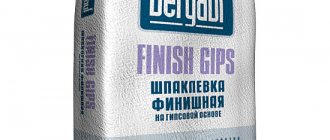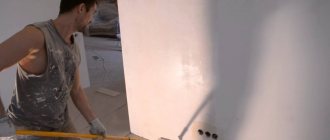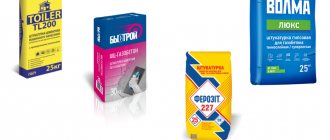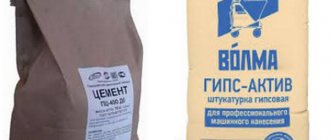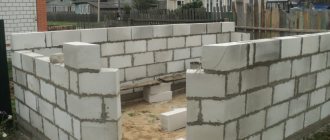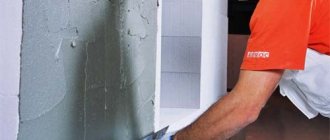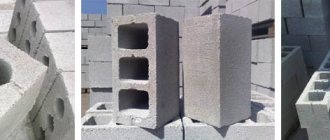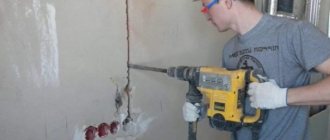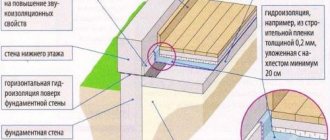Putty for exterior work not only gives the facade of the house a beautiful and well-groomed appearance, but it must also protect the wall material from the external influence of all unfavorable factors throughout the entire period of operation: summer heat, frost, wind, moisture, etc. To ensure a healthy microclimate inside the house , this material should not surround it with an impenetrable cocoon, leaving the walls breathable. Therefore, you need to approach the choice of putty responsibly, having first clearly defined what result will suit you.
What should you consider when choosing putty?
Today on the building materials market you can find a lot of good quality facade putties produced by world-famous construction corporations: Knauf, Ceresit, Vetonit, Volma, etc. They can be divided into two large groups: based on cement powder or polymers (latex or acrylic component). Polymer putties are produced in the form of ready-to-use paste mixtures, and cement-based putties are produced in the form of a dry powder, which must be diluted with water to the desired consistency immediately before use.
The size of the filler fraction in the putty is also important, since the quality of the treated surface directly depends on it: the smaller the fraction, the smoother the wall finished with putty will be. When choosing the type of putty for exterior work, you need to take into account that cement ones initially contain a larger filler fraction than polymer ones. When making a choice, you must take into account that even a beginner can work with ready-made polymer putties with his own hands, and the use of cement putties requires certain knowledge and work skills.
Puttying the facade
There are several mandatory conditions that must be taken into account when choosing putty for exterior use:
- setting speed;
- the time the material retains plasticity;
- water resistance;
- strength;
- frost resistance;
- vapor permeability;
- ability to resist cracking;
- simplicity and ease of application;
- compatibility with paints and varnishes.
Often, when choosing a putty for consumers, its price is of great importance. Here you need to take into account that Ceresit, Knauf and other well-known brands are not cheap, but when purchasing them, you can be sure of the quality of the products.
Classification of materials
Facade putty and ready-made in various consistencies. It depends on the manufacturer and purpose of the material.
The compositions are classified into:
- Starter – the material is considered as a leveling or base material.
- Finishing – a composition used at the last stage of external work. The material is fine-grained with a liquid consistency. Unlike the starting option, this façade putty is not as durable, but the end result is of high quality. This is possible due to its advantageous properties - easy and thin application (0.4 mm layer), flexibility for processing (grinding).
- Universal - the material includes the advantages of the two previous options, and is not used for external work on facades.
- Decorative - the composition is used to form objects for decorative purposes or create elements of stucco decorations fixed to the building from the outside.
- Facade putty for wood - used for the external walls of a wooden building to level the surface to a smooth state. In addition, the mixture is used as protection for wood that is vulnerable to weather conditions. It is suitable in cases where the cladding is made of wood.
Wood putty “Extra”
Facade putty for exterior use
Facade putty for exterior use
A lot of manufacturers produce finishing products
How to navigate a wide variety of finishing materials
Facade putty for finishing buildings
Another option for façade putty
There are products based on cement, which tolerates moisture and low temperatures, or polymer.
The group of polymeric materials includes acrylic/latex mixtures.
Advantages of acrylic-based material:
- Convenient to use.
- Easy to use.
- Quick drying period, not accompanied by cracking or shrinkage.
- No water is added to achieve the desired consistency.
What types of façade putties are there?
Despite the large selection of materials, all leading façade putty, Knauf, Vetonit, is divided into starting and finishing. The starting putty has a coarse-grained structure and is intended mainly for rough leveling the surface. It is characterized by high adhesiveness (the ability to stick to other materials: brick, concrete, wood, etc.) and extremely high strength. Thanks to these properties, it can be applied in a layer of up to 20 mm, leveling all cracks and surface irregularities.
The finishing façade putty has a fine-grained structure and is intended for finishing the surface to be treated. Compared to the starting putty, it is not as strong, so the finishing putty must be applied in a layer not exceeding 4 mm. The purpose of the finishing putty is to ensure maximum evenness and smoothness of the treated surface.
Facade finishing putty
Some produce universal putty, which can be used for initial leveling of walls and finishing.
This material is convenient because you don’t need to think about at what stage of construction work to use it.
But you need to take into account that, in comparison with special putties, it shows slightly worse results both during the initial leveling of surfaces and during their finishing. Therefore, they are used mainly for finishing the external walls of outbuildings, and when finishing the facades of residential buildings, it is preferable to use special putties.
Solution application technology
Facade putty can be applied manually and mechanically. The mechanical method requires a special unit. When using it, the requirements for the uniformity of the solution consistency increase.
The disadvantage of this method is that the putty is not applied evenly. Therefore, they often prefer to use the manual method. To work, you will need two spatulas, wide and narrow.
It is recommended to follow the following rules:
- The surface is pre-cleaned of dirt.
- Putty is first applied to all recesses, depressions, crevices, cracks, and the main irregularities are eliminated.
- Before applying a new layer, you need to allow enough time for the previous one to dry. The minimum time must be specified in the instructions.
- The drying period of the last layer is longer than the first. The putty must be protected from sudden temperature changes and exposure to direct sunlight.
- Do not apply putty in rain, snow, or sharp gusts of wind. The permissible temperature for work is from 5 to 30 C. Freshly applied putty must be protected from drying out and waterlogging.
- The wall is covered with mortar using beacons. The first stripes show the required layer thickness, then further work is carried out.
- After the putty has completely dried, the walls are sanded with abrasives.
Remember that:
- The instructions may indicate small “tricks” for this composition or working with it. Study all recommendations carefully.
- If you plan to paint the facade after puttying, then select a light composition, it will preserve the brightness of the paint.
Brief characteristics of facade putties
The most economical option is to purchase a dry plaster mixture and then prepare it in any suitable container to a working condition, diluting it with water according to the instructions. Almost all leading brands: “Starateli”, “Vetonit”, “Ceresit”, “Moment”, “Knauf” - produce such mixtures. Packaging, depending on the manufacturer, comes in 25 and 30 kg bags. The price of product brands in different regions may differ, but generally the market maintains a certain price parity.
The finishing putty is applied in a thin layer of maximum 4 mm
Well-known brands: “Ceresit”, “Vetonit”, “Knauf” and some others - produce special moisture-, frost- and heat-resistant putties on a polymer base (mainly acrylic). All these materials are produced in the form of a ready-to-use paste, so they have an important advantage (ease of application and ease of use). Such compositions dry quickly and practically do not shrink or crack. Their only drawback is their high price compared to dry plaster mixtures.
There are also polymer facade putties made on the basis of latex. Like acrylic ones, they are produced in the form of ready-to-use pastes that are odorless and do not emit harmful substances. Latex putties are characterized by enviable plasticity, durability and practically do not crack when dry. However, the price of latex putties is much higher than acrylic putties, not to mention the cost of dry plaster mixtures.
Frost-resistant putty
Which one to choose?
Before making a choice, you should evaluate the base of the wall, the quality of which will determine the composition of the putty material. It is recommended to putty surfaces with unevenness of more than five millimeters with a cement-based mixture. Smaller cracks can be perfectly closed with an acrylic-based solution.
Putty is also chosen taking into account the building material used to construct the walls. This rule is not neglected, because mixtures have strict classification.
Incorrect use of putty can result in low efficiency and subsequent damage to the finishing layer.
Another important factor for choosing is the time when the work is planned.
The winter season should be abandoned; it is better to postpone the puttying to the summer, waiting for dry weather. But if the work is urgent, purchase frost-resistant putty compounds.
Application stages
Putty is applied to facade walls in different ways, and the most effective among them is hardware, when the process uses a device that produces a mortar mass under high pressure. True, you will have to comply with a number of requirements - the mixture must be of the appropriate consistency in order to be applied in an even layer.
This finishing method involves a large amount of waste, so private developers are better off using hand tools.
In any case, a number of preparatory activities must be completed:
- clean the walls from the old finishing layer, if any;
- remove dust, dirt, oil stains;
- repair defective areas - cracks, chips, potholes;
- treat the surface with a deep penetration primer that increases adhesion and prevents the formation of fungus and mold stains.
A mortar mixture is prepared, and it is recommended to strictly adhere to the proportions of the components indicated on the packaging by the manufacturer of the material. If you purchased a ready-made composition for work, all that remains is to mix it.
Dry mixtures are mixed with water and mixed thoroughly until the required consistency is obtained.
To many, puttingtying walls will seem at first glance a simple process that does not require special skills. Almost every developer can master the technique, but there are a number of features that require mandatory compliance.
It is important to carry out the work steps in strict sequence:
- prime the walls;
- preparing putty;
- We level the wall surface with a rough layer;
- apply the finishing putty mixture;
- sand the dried surface before using the decorative material.

